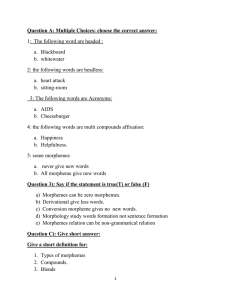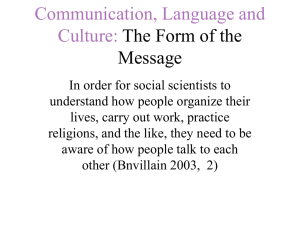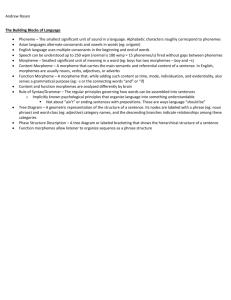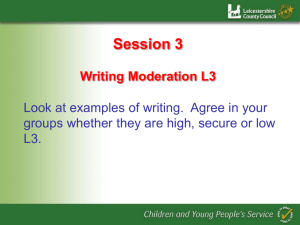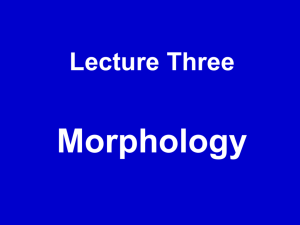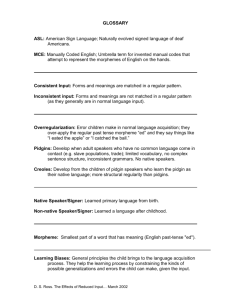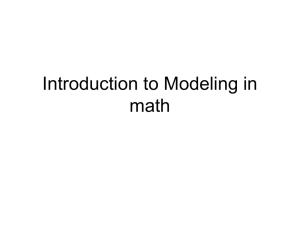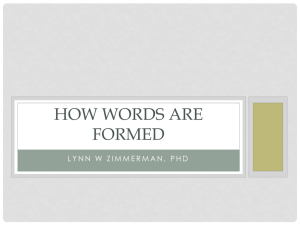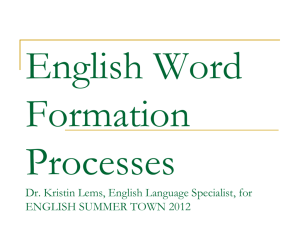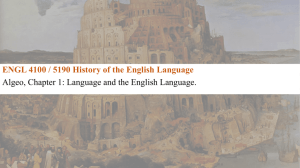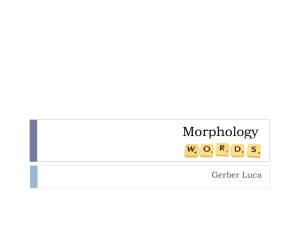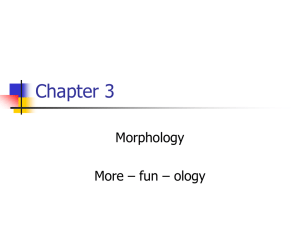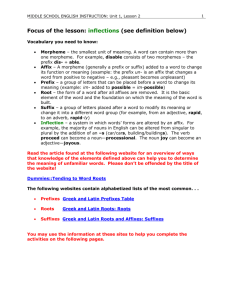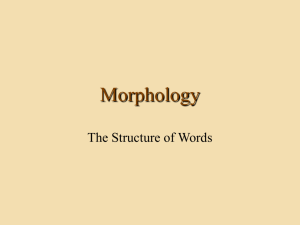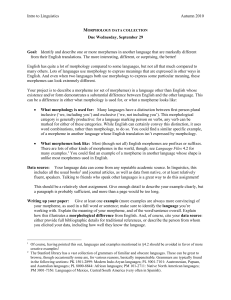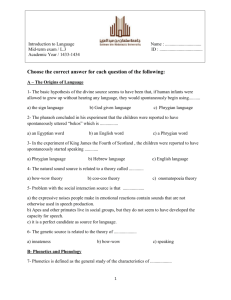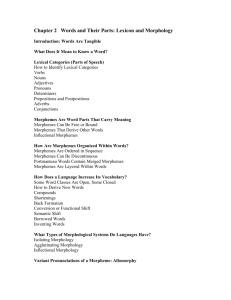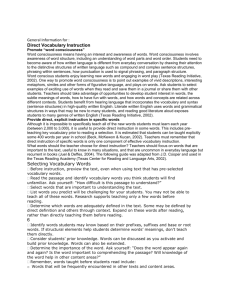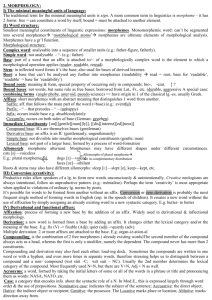Introduction to Word Analysis
advertisement
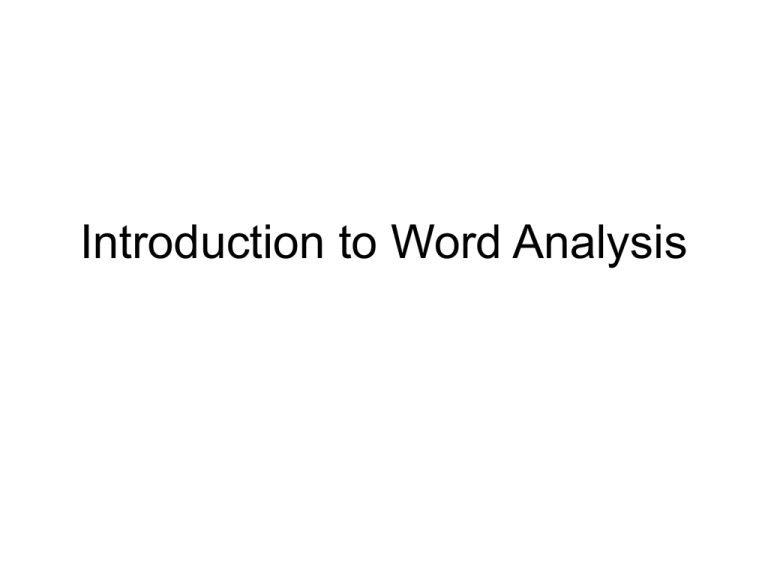
Introduction to Word Analysis What is Word Analysis? • Word analysis is a process of learning more about word meanings by studying their origins and parts. • A “morpheme” is the smallest meaningful part of a word. • Other terms for word analysis: • Morphemic analysis • Word study How is Word Analysis Important? • Words are more than a collection of letters: wonderful, review, disorder. • Students need to understand that words include more than one morpheme, each one with a story. • Analyzing words helps students see how words connect to cultures and linguistic patterns. Example 1: • Dis - order includes the prefix dis, based in the Latin meaning lack of or not. We can trace the root of the word order back to Latin and Italian origins. How Does Word Analysis Help Students? • The same morphemes appear in lots of words. • Knowing the meaning of a morpheme means your students will recognize it wherever it appears. • Morphemes give your students a head start in knowing something about hundreds of words— even very long ones. • Students with strong word analysis skills expand their vocabularies and draw upon new words as they read, write, speak, and learn. • How Can I Prepare Students to Use This Practice? • Provide clear explanations about what word analysis is and how to use it to define words. • Share strategies to help your students use word analysis. Model these strategies for students. • Give students lots of opportunities to study words as single or multiple units of meaning. Students who struggle with reading need many, focused experiences with word study. Discussion Questions 1 1. What challenges does word analysis present to struggling readers and/or ELL students? 2. In what ways can word analysis skills help students build academic vocabulary in science, social studies, and/or math? 3. Do you embed word analysis in reading and language instruction or teach separate, minilessons? How Can I Support Students' Use of Word Analysis? Use of Evidence-Based Practices • Provide Clear Explanations • Give Students Strategies and Models • Provide Opportunities for Practice Differentiated Instruction • Plan instruction that considers students' readiness, learning needs, and interests. • Use a range of technology tools to: – engage learners at varying levels – engage learners in multiple ways. – offer students options for demonstrating understanding and mastery Student-Dependent Ways to Differentiate • By Content – Different levels of reading or resource materials, reading buddies, small group instruction, curriculum compacting, multilevel computer programs and Web Quests, audio materials, etc. • By Product – Activity choice boards, tiered activities, multi-level learning center tasks, similar readiness groups, choice in group work, varied journal prompts, mixed readiness groups with targeted roles for students, etc. • By Process – Tiered products, students choose mode of presentation to demonstrate learning, independent study, varied rubrics, mentorships, interest-based investigations Teacher-Dependent Ways to Differentiate • By Readiness – Options in content, topic, or theme, options in the tools needed for production, options in methods for engagement • By Profile – Consideration of gender, culture, learning styles, strengths, and weaknesses • By Process – Identification of background knowledge/gaps in learning, vary amount of direct instruction, and practice, pace of instruction, complexity of activities, and exploration of a topic Discussion Questions 2 1. Are there specific diagnostic tests you use to determine the needs of your struggling readers? If so, what are they? 2. How do speech and language problems interfere with developing word analysis skills? 3. In what ways can technology support your instruction in word analysis? Activities Before Reading • Identify key words your students will encounter in the text. • Help your students break content area words into their sub-parts to prepare students to read the text. • Example: Photosynthesis – from photo- "light" + synthese "synthesis." from syntithenai "put together, combine," from syn- "together" + tithenai "put, place," Activities During Reading • Have students identify words with multiple morphemes as they read. • Keep a running list of words that students can add to over time. • Flag unknown words and model using the word study approach to discover their meanings. • Encourage students to use context clues to help identify meanings. Activities After Reading • Review new words found as a class. Ask students to point out the words with multiple morphemes. • Ask students to identify morphemes they recognize. • Help students see patterns: for example, students may read “bio” often in science: biology, biodegradable, biome, biosphere, etc. • Build word groups with the same prefixes or suffixes. Discussion Questions 3 1. How can your students take advantage of the features of digital text by color coding, highlighting, and underlining morphemes and root words when reading online? 2. What types of speaking, drawing, and/or writing activities might help to reinforce these skills for your struggling students? Disclaimer Awarded through a cooperative agreement from the U.S. Department of education, Office of Special Education Programs (OSEP), Grant #H327G090004-10, PowerUp What Works was developed by a team of experts in education, technology, differentiated instruction/UDL, and special education at the Center for Technology Implementation, operated by the American Institutes for Research (AIR) in collaboration with the Education Development Center, Inc. (EDC) and the Center for Applied Special Technology (CAST). • This document contains information from other public and private organizations that may be useful to the reader; these materials are merely examples of resources that may be available. Inclusion of this information does not constitute an endorsement by the U.S. Department of Education of any products or services offered or views expressed. This publication also contains hyperlink s and URLs created and maintained by outside organizations and provided for the reader's convenience. The Department is not responsible for the accuracy if this information. Further, the programs/models/resources featured on this site have not been extensively evaluated by CTI. This website was created and is maintained by American Institutes for Research (AIR) through funding from the U.S. Department of Education, Award # H327G090004. For more information, send an e-mail to PowerUp@air.org.

